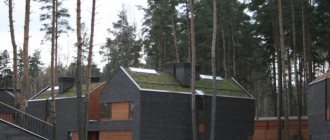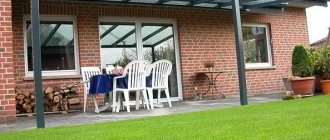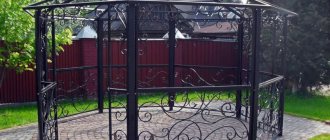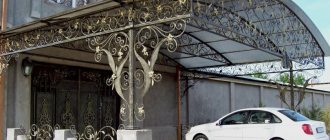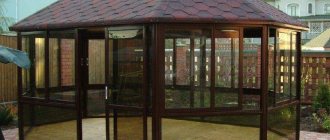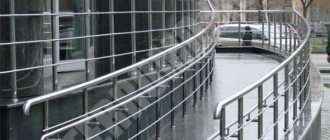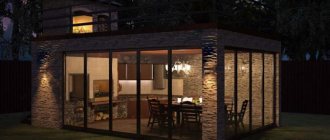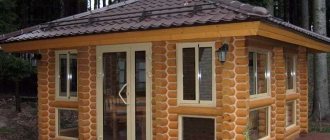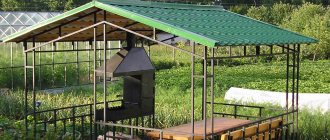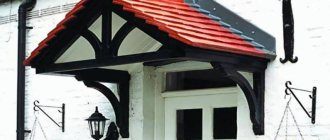Types of roofing polycarbonate
They produce different types of polycarbonate for roofing. With this modern ceiling you can make unique designs. One of the types is cellular; special polymers are used for its manufacture. It is characterized by light weight. In appearance, these are profile panels that are connected by rigid ribs. It is used to create unusual, non-standard arched and dome structures. It is recommended to use it for covered loggias and gazebos.
Monolithic is a smooth coating. It has a transparent structure. This fairly rigid reinforced polycarbonate is obtained by joining two sheets. A banner or other PVC mesh is placed between them. As a result, the material is stronger and can additionally withstand high loads. There is another method of modifying the quality of polycarbonate - reinforcement with glass fiber with a small alkali content. At the same time, in addition to increasing strength, the material becomes more resistant to creep at elevated room and temperature.
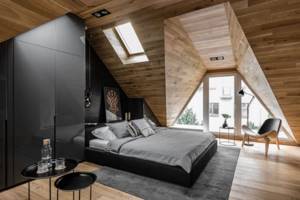
Material selection
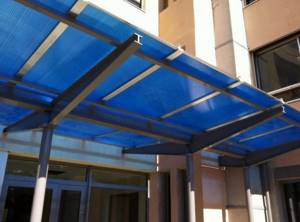
Before you start installing a polycarbonate roof with your own hands, you need to prepare a project. The choice of material plays a huge role. The frame and fastening system are determined based on the roof model. If the plan provides for a monolithic structure in which there will be no joints, then you should buy polycarbonate racks. As a result, the resulting coating will be cast.
It is necessary to take into account the thickness of the sheet, because this indicator determines whether the structure will withstand the loads placed on it. Sheets with a thickness of 4 mm are used for small areas with curves. They are mainly purchased for individual roof parts and canopies. Craftsmen advise choosing 6-8 mm canvas for residential buildings subject to wind and snow loads. They can be used to build carports and swimming pools. Thick canvases measuring 10 mm are used to cover buildings in areas where difficult climatic conditions are observed. There, buildings need to be protected from the negative effects of the external environment. The architectural features of buildings must also be taken into account. One of the tasks of roofing material is to emphasize the beauty of the exterior of the building. The most commonly used panels are the following colors:
- brown;
- blue;
- dairy;
- green;
- golden brown.
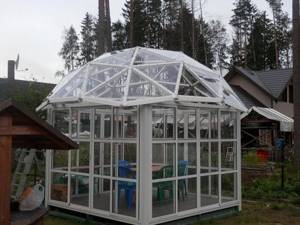
Details
Advantages and disadvantages of polycarbonate buildings
A garage for a car is like a kind of home. This is where she will spend all her “free time”. This structure protects it from the negative influence of the environment. For this reason, when purchasing a personal vehicle, you should immediately think about where it will “rest”. There are quite a few options for such a structure, and today we will talk about a budget option for building a building, which is not so difficult to carry out with your own hands. Read on to learn more about building a polycarbonate car garage. So, a garage can be made from old greenhouses, since this building has a frame.
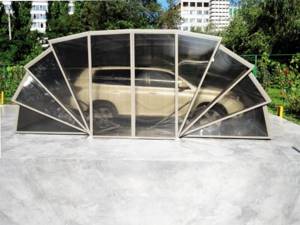
For this reason, work on building houses for the car will be minimal. Making a garage out of polycarbonate is an inexpensive and easy to implement idea. It has its pros and cons, which are worth familiarizing yourself with. The advantages are:
- It is convenient and easy to work with such material - it is pliable, flexible and makes it possible to build a garage in a short time.
- The flexibility of the material makes it possible to create a garage of absolutely any shape using it. For example, if you can build a structure in the form of a hemisphere.
- The lightness of the material simplifies the work. This same property also makes it possible not to make an overly massive frame for it.
- The material is relatively inexpensive, and therefore building a garage from such material will not require large expenses.
- Polycarbonate buildings look quite modern and fashionable, and the color variety makes it possible to create the most non-standard designs.
Naturally, such types of material also have some disadvantages, and it is worth familiarizing yourself with them so as not to be disappointed with the choice.
Disadvantages of such a polycarbonate garage:
- Such a structure does not protect the premises from thieves, which is why it can only be built in those areas that have their own protection from intruders.
- A car garage built from polycarbonate is not extremely durable. It can be easily damaged by mechanical influence.
- Polycarbonate garages require a metal frame, and the fact is that it will need to be welded.
- Polycarbonate is a translucent or transparent material, and therefore it will always be visible what you are doing indoors.
If you are not afraid of all the disadvantages described above, then you can safely build a garage out of it. This structure can be built in a short time and will be inexpensive.
Variations of polycarbonate roofing
Which polycarbonate should I use for my garage frame? Before you begin the process of building a garage, you should definitely decide on the type and shape. There are two likely options, which have certain pros and cons. There must be light inside the room, and therefore you will need to decide in advance how exactly you will conduct electricity there. First of all, garages must necessarily differ in their overall design, and we invite you to consider what options are available. Types of garages built from polycarbonate:
- A canopy is the simplest building to build, and in this case you only need to make a roof on metal supports. The side components of the structure should not be sheathed with polycarbonate, and such a structure is as simple as possible to construct, although the canopy is not capable of fully protecting the car in winter. For this reason, this option can be called temporary.
- A full-fledged car garage, built of polycarbonate, will protect the car from all sides. By the way, in the case of polycarbonate, this option is not much more complicated in terms of execution than the previous one. You will only need to add a few side supporting elements to the frame, and also make a gate frame. But it will be a little more expensive, because you will also need to purchase polycarbonate for the walls of the building.
You will also need to determine what the shape of the roof will be.
There are various options for polycarbonate garages. Types of garage roofs made from polycarbonate sheets:
- In the case of polycarbonate, a straight roof is far from the best option, since precipitation will accumulate on it, which can damage it.
- Single-pitch options are a better option, but still the amount of precipitation that can accumulate on it is quite large.
- Gable roofs are perfect for a garage built of polycarbonate. Precipitation will not accumulate on it and it will be more difficult to make a frame for it.
- A semicircular roof looks quite nice, although this option is complicated by the peculiarities of building the frame.
The best roof option can be considered semicircular and gable. They will ensure minimal precipitation accumulation.
Preparatory stage before construction
First of all, it is worth starting to build the garage, and it is worth reproducing certain preparatory work. We invite you to familiarize yourself with all the working stages.
Preparation work:
- The first thing you should do is calculate all the dimensions for the future garage space. It will greatly depend on the size of the car, and it should be 2 times wider than the car. The height should be chosen so that you can enter it without any problems.
- When you decide on the size and type of car garage, you should draw up or select a ready-made drawing.
- Then choose a type of base and you can use monolithic bases, but in reality a simple strip base will be sufficient.
- Dig a trench with a depth of 0.3 to 0.5 meters and make formwork, and it is advisable to make a reinforced base for the base. This will make it stronger.
- Pour sand into the bottom of the trench and then compact it. Pour crushed stone on top, and the thickness should be at least 0.1 meters. Then fill in the cement solution.
Before starting other work, you should wait until the foundation hardens completely. How long this process will take will depend on weather conditions.
How to make a garage from greenhouse material yourself
To get inspired, look at photos of polycarbonate garages.
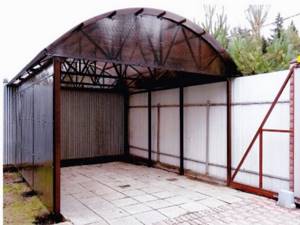
After this, it will be possible to begin making the car garage itself. We invite you to familiarize yourself with the main stages of such work.
How to make a polycarbonate garage:
- The first step is to weld the frame, and it should include a horizontal bottom base, and for the side walls you will need at least 3 vertical metal load-bearing elements. In the place where the garage door will be installed, a load-bearing foundation will be required for it. with a roof it will be more difficult, because the frame shape will depend on the type of product. But such premises must always be strengthened, and carefully, because it will be affected by precipitation.
- The frame is fixed to the base using massive dowels.
- The frame must be sheathed with polycarbonate sheets, and for this, self-tapping screws with thermal washers are used.
The most difficult part of the work will be welding the frame, and it is this element that will determine how strong the entire structure will be.
Advantages and disadvantages
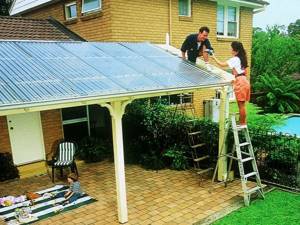
Polycarbonate is one of the most common building materials, largely due to its high quality. It reliably protects the room from bright sunlight. The light penetrating through the roof is scattered evenly, while ultraviolet rays do not pass through. When installing a roof with profiled sheets, you do not need to use an additional fastening system, because they are not heavy. Due to the fact that the material is not very expensive, it is often used to create structures of any design. Polycarbonate has increased sound, steam and waterproofing properties, good thermal conductivity, so the roof can be installed without insulation and there is no need to lay thermal insulation.
May be interesting Do-it-yourself decorative cover for a septic tank: original ideas with photos Do-it-yourself garden arch: step-by-step instructions for creation What to consider when designing a house made of profiled timber
The coating has a smooth surface, so precipitation does not linger on it. Thanks to its flexible structure, it can be shaped and bent in various directions. The sheets are easy to transport, cut, glue, and drill.
Using corrugated polycarbonate for the roof will add expressiveness to the building. Since the material is relatively plastic, it will hold up well even in areas with hot climates. The wavy surface will not be crushed by a thick layer of snow, nor will strong gusts of wind tear it. Due to its low thermal conductivity, such a roof provides excellent protection from heat and cold.
In contrast, under a monolithic canopy in extreme heat it will be very hot. Corrugated sheets are not afraid of water, they are not afraid of chilled smoke or detergents. However, the polymer can be partially dissolved by chemical solvents.
The main disadvantage of a monolithic profile sheet is its ability to collapse in a short time under the influence of ultraviolet rays. Therefore, if the protective film is damaged, you will have to make repairs, otherwise the roof will collapse in 3-4 years. The monolith catches fire. The cause of the fire may be poor wiring or illumination of the transparent roof. There are no ways to prevent combustion. When the temperature changes, polycarbonate makes clicks and crackles. This means that at this time the material itself is deformed.
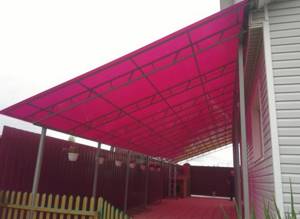
It must be borne in mind that if the material bends too much, it will lose integrity, and the color may become cloudy. It must be handled carefully and carefully. For storage, you need to choose a place where direct sunlight does not penetrate, where good ventilation is provided. Sheets should be stored horizontally without removing the special protective film.
Characteristic
Cellular polycarbonate is a polymer material. Inside it has many small air chambers, which provide good sound and heat insulation. It cuts, drills, bends, and glues well. Such a roof prevents snow and water from accumulating on its surface.
Polycarbonate is available in different thicknesses - from 4 to 16 millimeters. Especially when you consider all its advantages, positive properties and affordable price.
Polycarbonate is produced in the form of sheets with a thickness of 4 to 32 mm. The standard width of such a sheet is 2100 mm, length 6000 mm, sometimes 12,000 mm. Sheets with a thickness of 4-6 mm are intended for the production of advertising boards, signs and inscriptions. For construction purposes, polycarbonate with a thickness of 8-16 mm is used. Sheets with a thickness of 20 mm or more are rarely used. Based on the quality of the material and service life, it is divided into categories. The Premium category has a guaranteed service life of more than 20 years. Elite class - minimum 12 years. The “Optimal” class is designed for a service life of up to 10 years. The cheapest "Economy" - up to 8 years.
Related article: Space above the bed in the bedroom: decor and design ideas (37 photos)
Main advantages:
- light transmission more than 90%;
- 15 times lighter than glass;
- does not transmit ultraviolet rays;
- high impact resistance;
- resistance to temperatures from -50 to +20°C;
- does not crack in the cold;
- does not release toxins in the heat;
- average service life - more than 12 years;
- ease of processing and assembly.
How to make a polycarbonate roof with your own hands
Before starting construction, you need to study photos and drawings of a polycarbonate roof with your own hands and draw up a project. This will allow you to correctly calculate how much material you will need to buy. The diagram must indicate the dimensions of the building and the configuration of the future structure. When starting to build a polycarbonate roof for a gazebo or other structure, you need to make sure that all the necessary materials and tools have been purchased, look at how the frame is assembled, and make sure that it is assembled correctly. You need to purchase the required number of side and end profiles, sealing tapes, sealing washers, special screws, etc.
Attention!
Experts strongly advise you to follow the recommendations specified in the instructions.
Preparatory stage
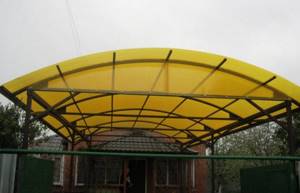
Before you start covering the roof, you first need to remove the protective packaging film only along the edges along the lines that are to be fastened. There is no need to remove everything; it may happen that during work the surface is accidentally scratched. The ends of the cellular polycarbonate are covered with temporary tape, which prevents moisture and dust from penetrating inside the channels. It is removed, and a perforated tape is glued along the lower cut, and a sealing tape is glued to the upper cut. If the sheet does not fit into any mounting profile, you must remember to cover the tapes with end profiles. The top one is hermetically sealed, and at the bottom section of the profile, pre-drill holes through which condensation will drain from the internal cavities. The diameter of the drainage holes should be 2-3 mm, the distance between them 30 cm.
Before covering the roof of a veranda or other wooden structure, it is necessary to finish painting the wooden supporting structures. If you are going to install a polycarbonate roof on canopies, or make canopies from this material, all work related to metal welding should be completed. The supporting structure under a transparent roof will not heat up much if it is painted with white paint that does not fade. But you can cover the horizontal planes of the wooden sheathing with aluminum tape.
Fastenings
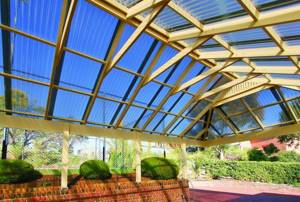
Polycarbonate sheets are attached to the sheathing with self-tapping screws, for which holes should be drilled. Their diameter should be larger than that of self-tapping screws. The holes are made, departing from the edge of the sheet by at least 4 cm. When making a roof from cellular polycarbonate, it is necessary that the fasteners in this material are located between the air channel and do not get into the stiffener rib. The screws must enter at right angles to the surface of the sheet. For load-bearing structures made of wood, fixation is carried out with wood screws, for a metal frame - with a drill. These two types must be used with a rubber sealing washer, due to which the roof will not leak through these places in the future. The distance between the fastenings is 40-60 cm. It is not recommended to tighten the fastenings too much. Otherwise, as a result of temperature fluctuations, the panels will move relative to the grille.
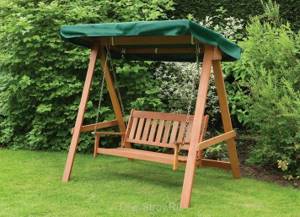
Useful tips
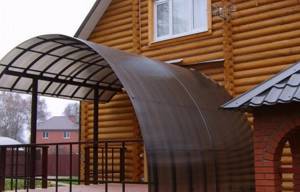
Since polycarbonate sheets are easy to work with, you can try to cover the roof yourself. It is advisable to listen to the advice of professionals. When preparing, the material must be placed on a flat and dense surface. You must not allow it to shake, otherwise it will crack. To apply markings, use a marker, which does not wear off during use, and can then be easily removed with alcohol. The panels are sawed at low speed using blades with small, straight-toothed teeth. At high speeds, the plastic melts and deforms. Cut using:
- circular saw;
- electric jigsaw;
- hacksaws for metal;
- band saw;
- sharp knife.
All sheets must have smooth cuts, without protrusions. Although polycarbonate is strong, it is, however, a fragile material. When drilling holes, do not press too hard on the surface, otherwise it will burst. To prevent the panels from being accidentally damaged during assembly, the protective film is removed after completion of the work. The smallest chips and dust formed during cutting must be blown out using compressed air. Polycarbonate is sanded with sandpaper and cooled water. Finally, sandpaper with a grain size no higher than 600 is used. If the sheets are to be glued together, then before doing this they must be cleaned of dirt. For gluing you need to buy a special varnish and solvent.
A large number of consumers notice that in reality polycarbonate can last longer than the manufacturer guarantees. Up to 25 years, high-quality material with excellent technical characteristics, produced from excellent raw materials with precise adherence to technology, can be suitable. When purchasing panels, you should check for damage or swelling of the protective film. For colored sheets, you need to pay attention to the uniformity of coloring. Extending the useful life largely depends on the buyer. It is necessary to take into account the peculiarities of transportation, storage, and assembly.
Attention!
Prices vary depending on the types of polycarbonate for the roof, the size of the sheets, and the manufacturer.
Fastening methods
There are two main types of installation: wet and dry.
The wet method involves the use of polymer putty, which is applied along the entire perimeter of the frame. The sheet is placed on a layer of putty and pressed tightly to the base. The putty can be replaced with elastic rubber gaskets. The sheet is attached at the corners or along the long sides. The joints are additionally sealed with silicone sealant and wooden or plastic corners for decoration. This method is used infrequently. The dry method is most often used. It is more clean and tidy. All connections with this method are made using self-tapping screws, bolts, screws, and nuts.
Roof installation
There are a number of requirements for the roof structure:
To connect polycarbonate panels, various types of profiles are used, which are selected depending on the design.
- the roof mounted from polycarbonate must provide a certain level of illumination;
- should protect working areas of the premises from direct sunlight;
- the roof must have ventilation;
- snow from the roof must be removed in a timely manner and without much difficulty;
- the roof must have a solid structure;
- mandatory presence of sound insulation, thermal insulation, vapor barrier and waterproofing.
The roof is mounted on structures made of special profiles. Profiles are made of steel and aluminum. Steel ones are used for the construction of large spans, aluminum ones for medium and small spans. There are profiles for pitched roofs.
To secure the sheets to the profile frame, special self-tapping screws with washers are used. They are placed every 30-40 cm. There are special polycarbonate fastening profiles and plugs for the end parts of the sheet. The plugs prevent dust and insects from entering the air chambers of the sheet.
Related article: How to make a kitchen out of wood with your own hands
Is it possible to install polycarbonate in winter?
As for the manufacturers of this building material, they allow the installation of polycarbonate in winter. But professional roofers do not recommend covering the roof if the temperature outside is below freezing. The point is that it is impossible to predict the size of thermal expansion. For example, at negative temperatures the gaps will be 1-2 mm in size, and in the summer the coating may bend. This material's ductility decreases in winter. Plates are harder to cut and drill. Installation becomes more difficult on semicircular buildings.
A polycarbonate roof will last longer if you take care of this coating and clean it regularly. In areas where snow falls little and infrequently, it is not necessary to clear snow from polycarbonate roofs and canopies. If there is a lot of it, then you need to carefully clean the surfaces with a broom. Due to the fact that the material is brittle in winter, shovels cannot be used. The rest of the time, accumulated dirt is removed with ordinary detergents, which should not contain chlorine, alkalis, acids and ammonia.

